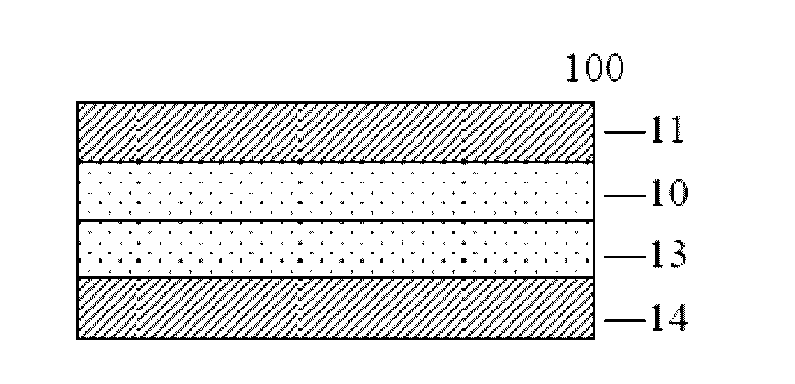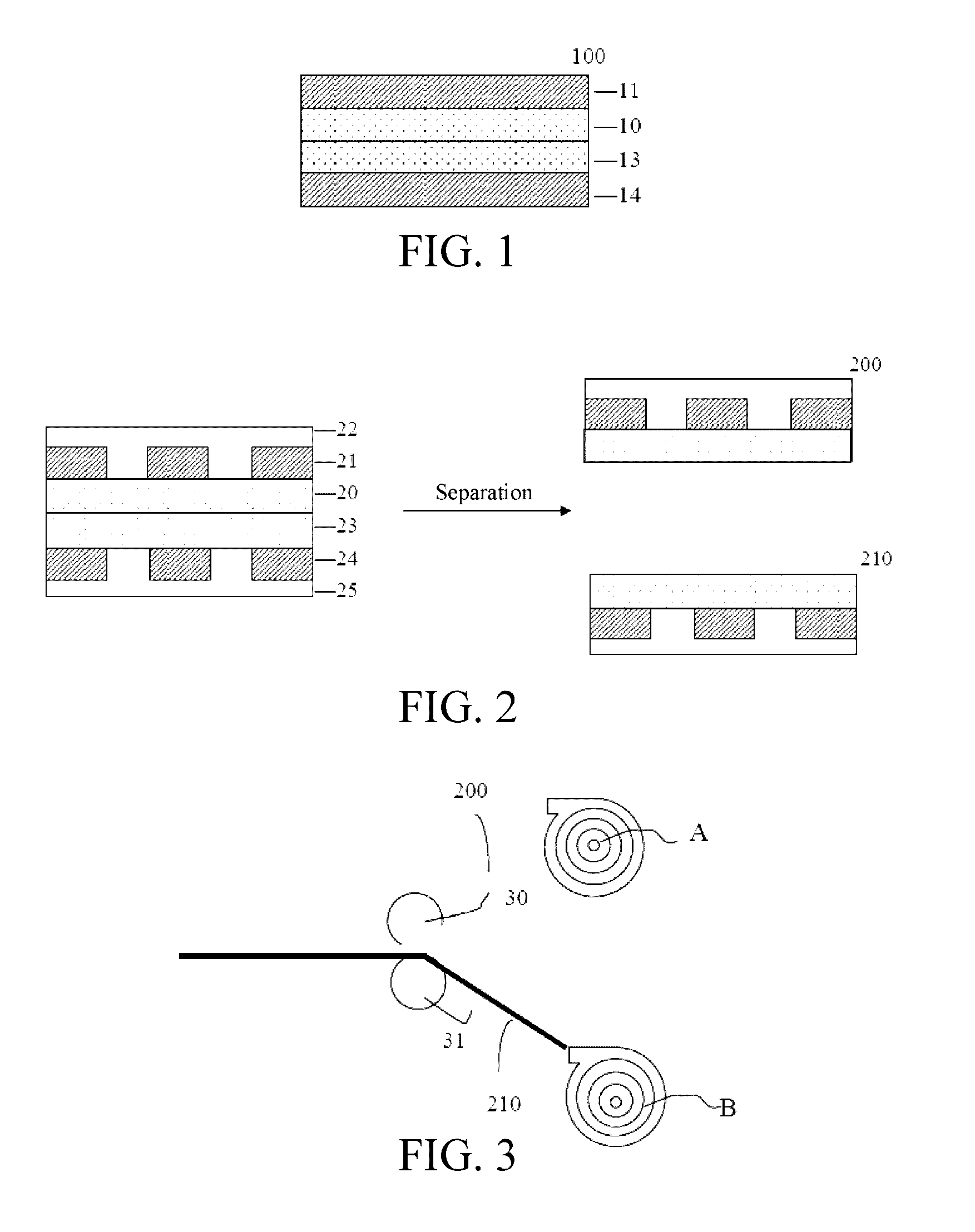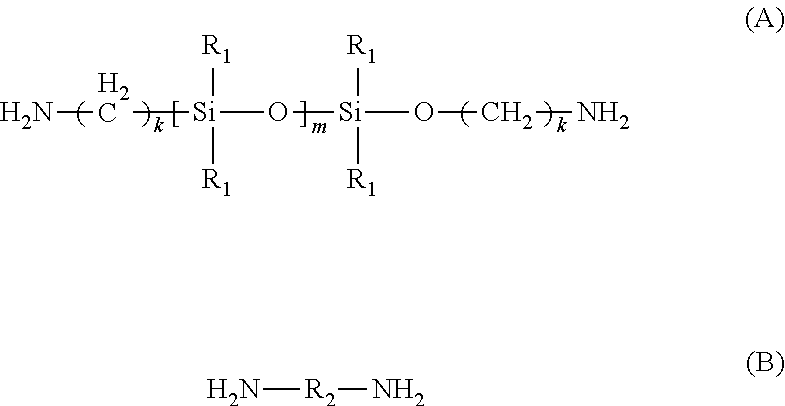Polyimide resin and metal-clad laminate comprising the same
a technology of polyimide resin and metal-clad laminate, which is applied in the field of polyimide resin, can solve the problems of affecting yield, complicated and time-consuming, and the thermoplastic polyimide layer has less dimensional stability and heat resistance, so as to avoid warpage, simplify the process, and save time and cos
- Summary
- Abstract
- Description
- Claims
- Application Information
AI Technical Summary
Benefits of technology
Problems solved by technology
Method used
Image
Examples
example 1
[0109]58.84 g (0.2 mol) of 3,3′,4,4′-biphenyltetracarboxylic dianhydride (BPDA) and 43.62 g (0.2 mol) of pyromellitic dianhydride (PMDA) were dissolved in 2064 g of NMP. 2.32 g (0.02 mol) of 2-hydroxyethyl acrylate (HEA) was slowly added dropwise, and reacted for 2 hrs at 50° C. with stirring. Then, 20.02 g (0.1 mol) of 4,4′-oxydianiline (ODA), 24.85 g (0.1 mol) of PAN-H and 21.63 g (0.2 mol) of p-phenylene diamine (PPDA) were added to the solution, and reacted for 6 hrs at 50° C. with stirring after complete dissolution, to obtain a solution containing a first polymer precursor.
[0110]Then, 176.53 g (0.6 mol) of BPDA was added to the solution, stirred for 30 mins, followed by the addition of 64.89 g (0.6 mol) of PPDA, and then reacted for 6 hrs at 50° C. with stirring after complete dissolution, to form a second polymer precursor. The resulting formulation PAA-A1 contained the first polymer precursor and the second polymer precursor, and had a solids content of 20%. The first polyme...
example 2
[0112]58.84 g (0.2 mol) of BPDA and 43.62 g (0.2 mol) of PMDA were dissolved in 2059 g of NMP. 2.32 g (0.02 mol) of HEA was slowly added dropwise, and reacted for 2 hrs at 50° C. with stirring. Then, 24.03 g (0.12 mol) of ODA, 19.88 g (0.08 mol) of PAN-H and 21.63 g (0.2 mol) of PPDA were added to the solution, and reacted for 6 hrs at 50° C. with stirring after complete dissolution, to obtain a solution containing a first polymer precursor.
[0113]176.53 g (0.6 mol) of BPDA was added to the solution, stirred for 30 mins, followed by the addition of 64.89 g (0.6 mol) of PPDA, and then reacted for 6 hrs at 50° C. with stirring after complete dissolution, to form a second polymer precursor. The resulting formulation PAA-A2 contained the first polymer precursor and the second polymer precursor, and had a solids content of 20%. The first polymer precursor accounted for 40 mol % of the moles of the total polymer precursors.
[0114]Then, the process as describe in Example 1 was used to apply ...
example 3
[0115]58.84 g (0.2 mol) of BPDA and 43.62 g (0.2 mol) of PMDA were dissolved in 2054 g of NMP. 2.32 g (0.02 mol) of HEA was slowly added dropwise, and reacted for 2 hrs at 50° C. with stirring. Then, 28.03 g (0.14 mol) of ODA, 14.91 g (0.06 mol) of PAN-H and 21.63 g (0.2 mol) of PPDA were added to the solution, and reacted for 6 hrs at 50° C. with stirring after complete dissolution, to obtain a solution containing a first polymer precursor.
[0116]176.53 g (0.6 mol) of BPDA was added to the solution, stirred for 30 mins, followed by the addition of 64.89 g (0.6 mol) of PPDA, and then reacted for 6 hrs at 50° C. with stirring after complete dissolution, to form a second polymer precursor. The resulting formulation PAA-A3 contained the first polymer precursor and the second polymer precursor, and had a solids content of 20%. The first polymer precursor accounted for 40 mol % of the moles of the total polymer precursors.
[0117]Then, the process as describe in Example 1 was used to apply ...
PUM
| Property | Measurement | Unit |
|---|---|---|
| glass transition temperature | aaaaa | aaaaa |
| glass transition temperature | aaaaa | aaaaa |
| glass transition temperature | aaaaa | aaaaa |
Abstract
Description
Claims
Application Information
 Login to View More
Login to View More - R&D
- Intellectual Property
- Life Sciences
- Materials
- Tech Scout
- Unparalleled Data Quality
- Higher Quality Content
- 60% Fewer Hallucinations
Browse by: Latest US Patents, China's latest patents, Technical Efficacy Thesaurus, Application Domain, Technology Topic, Popular Technical Reports.
© 2025 PatSnap. All rights reserved.Legal|Privacy policy|Modern Slavery Act Transparency Statement|Sitemap|About US| Contact US: help@patsnap.com



